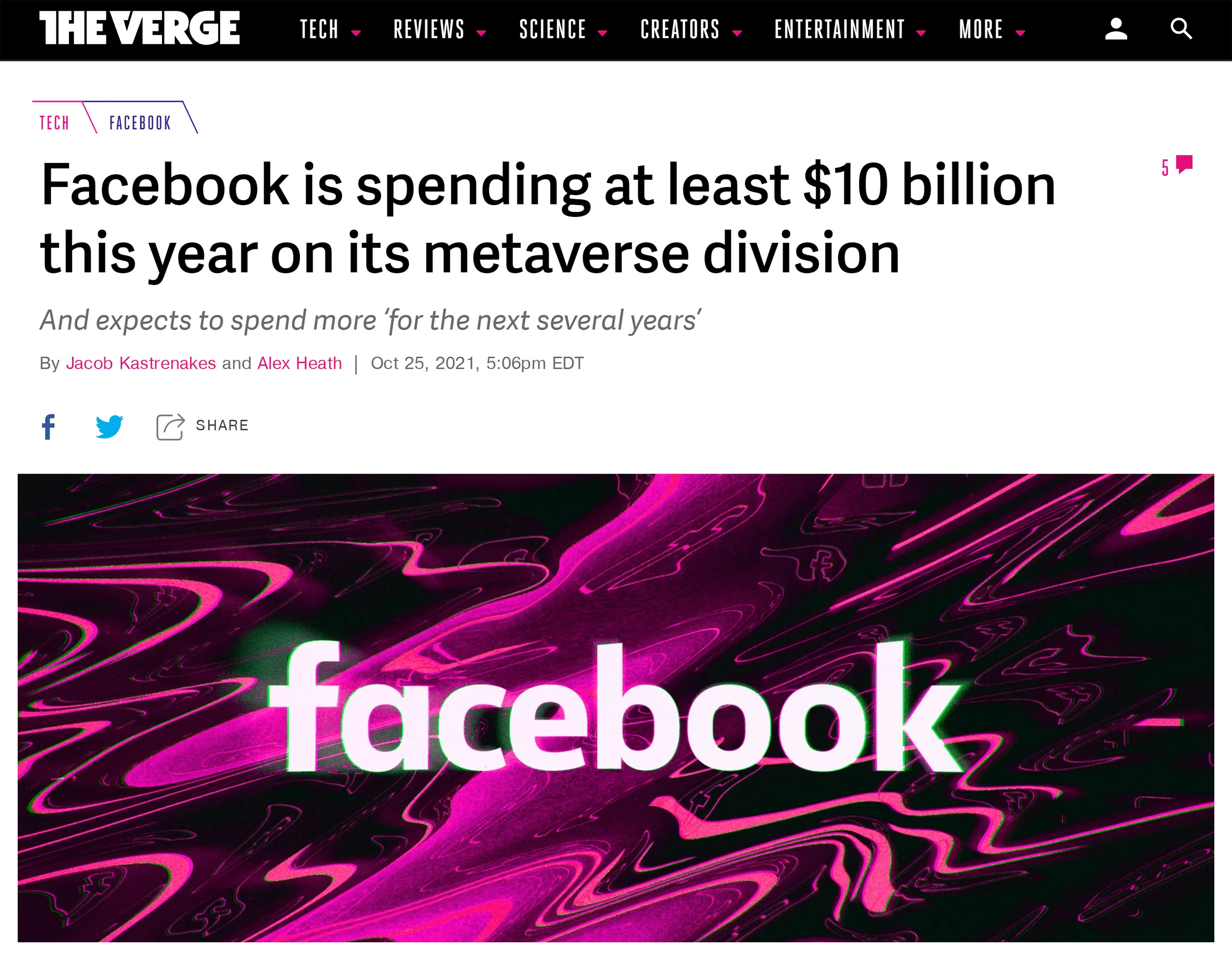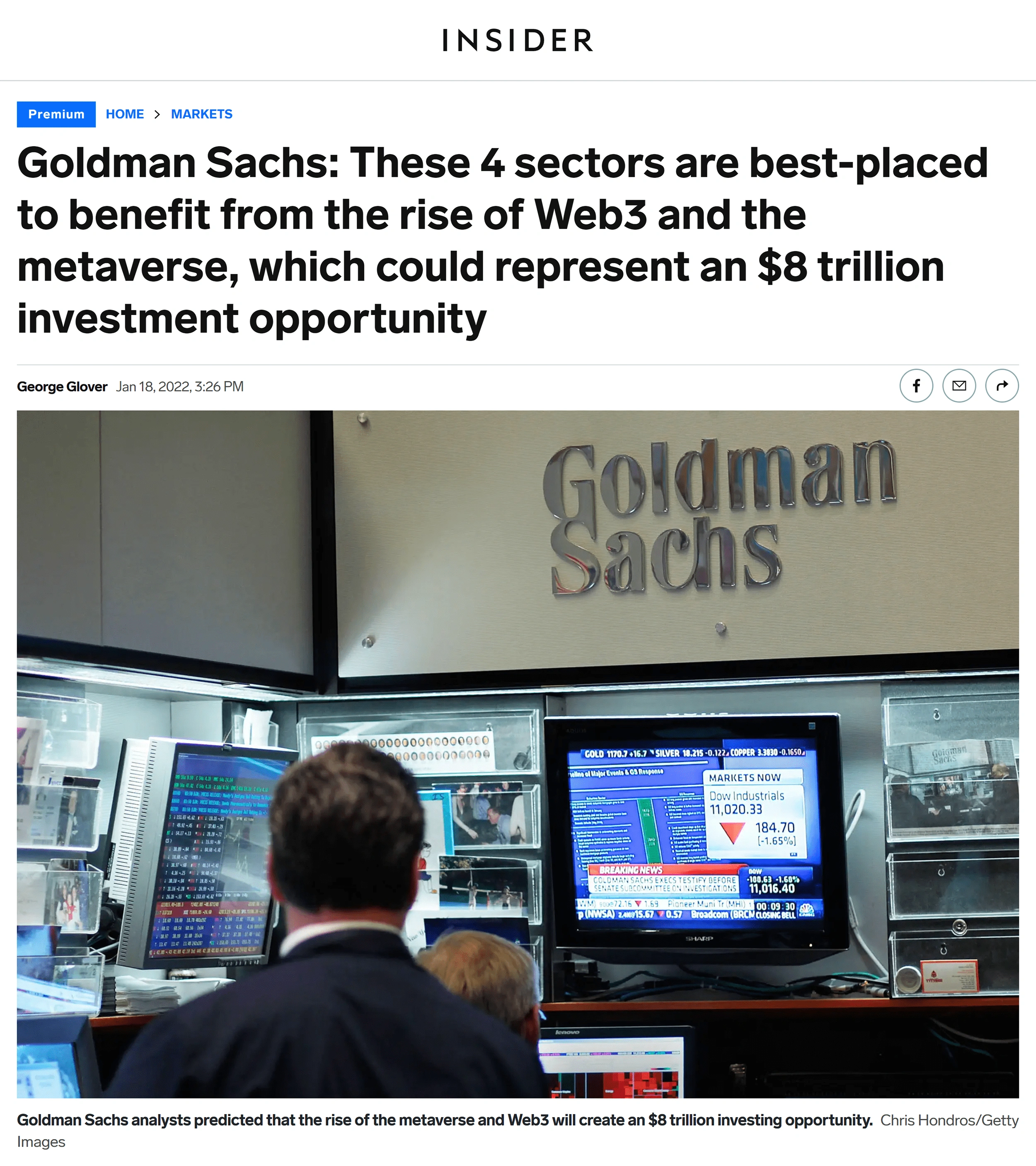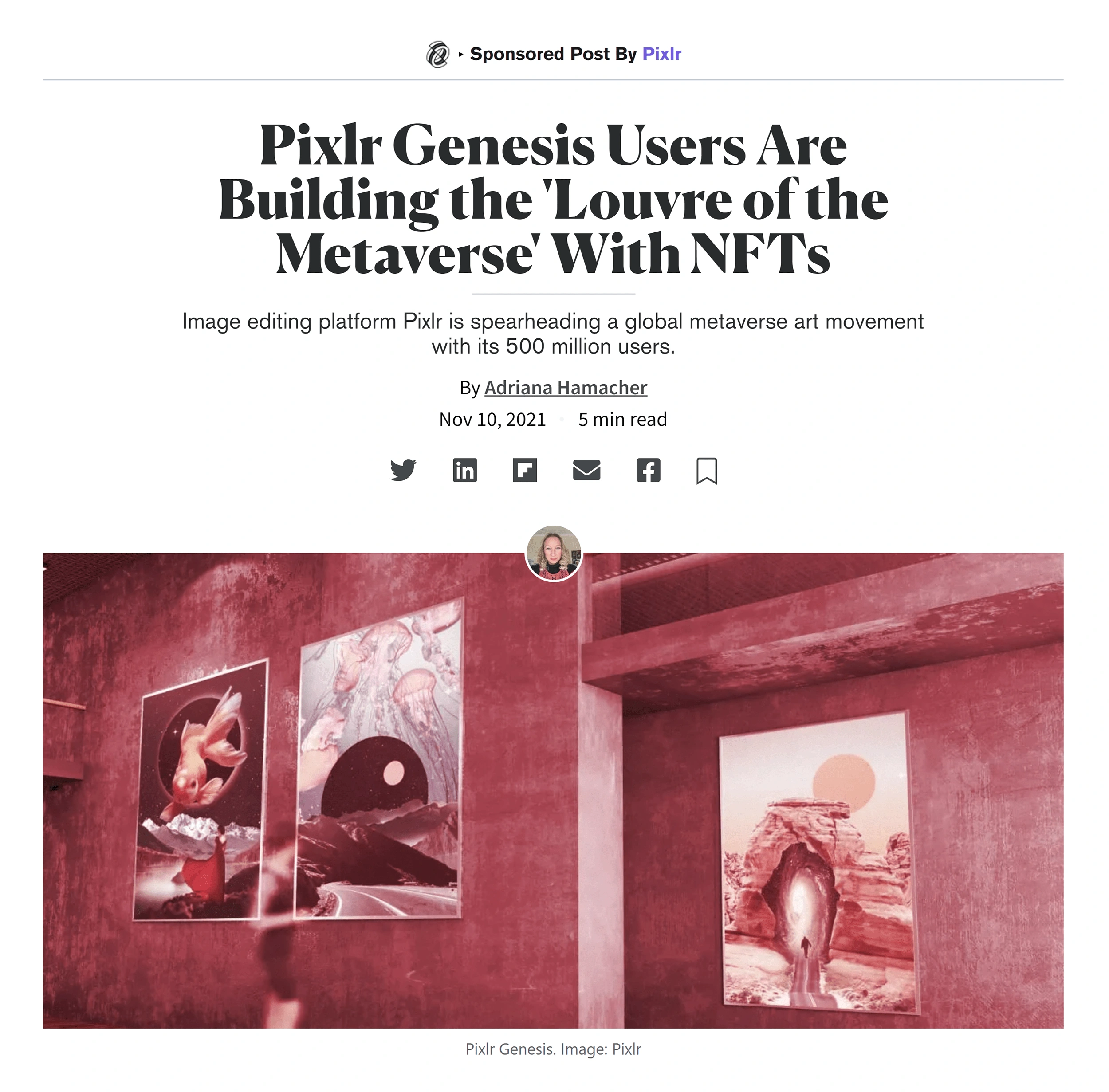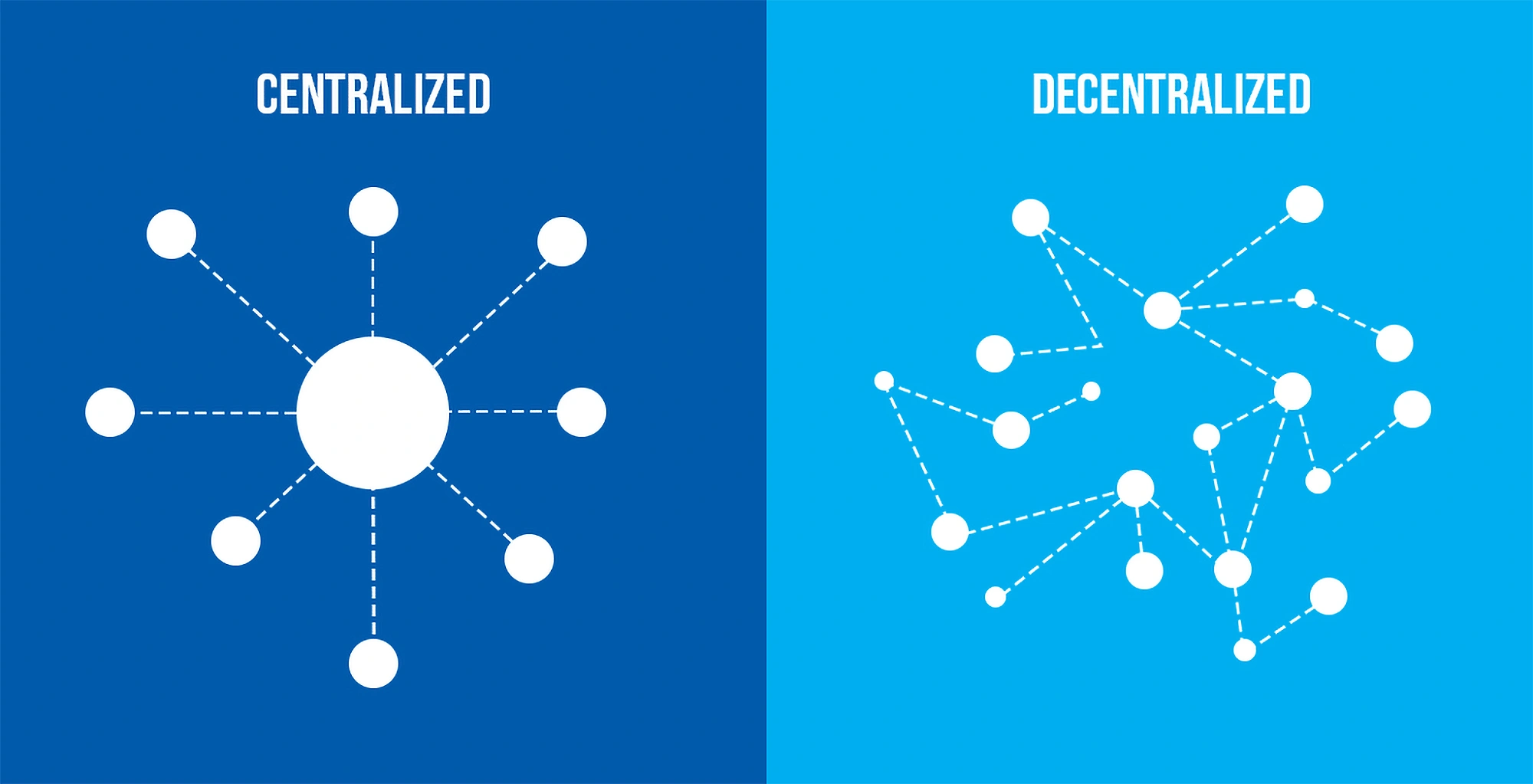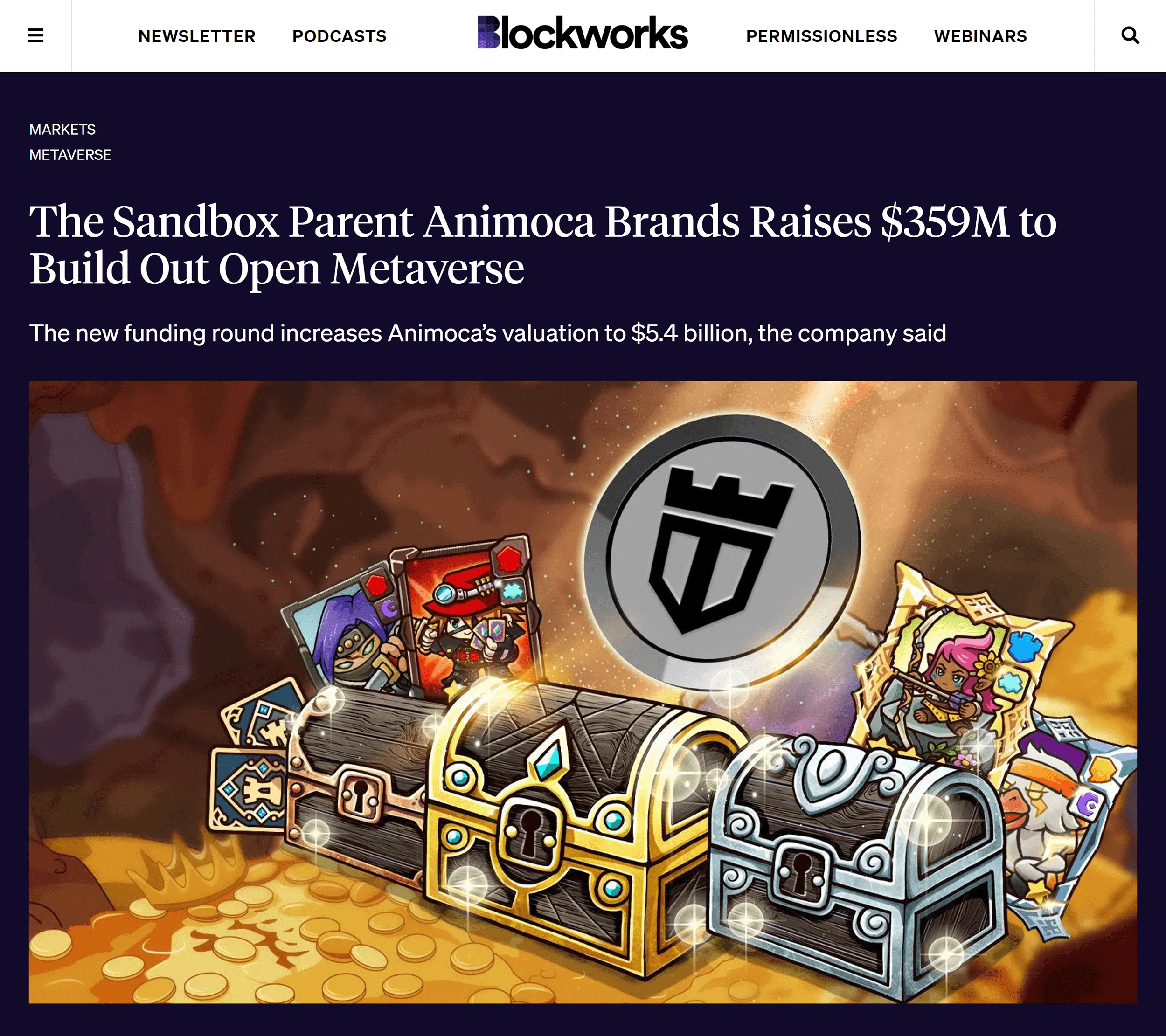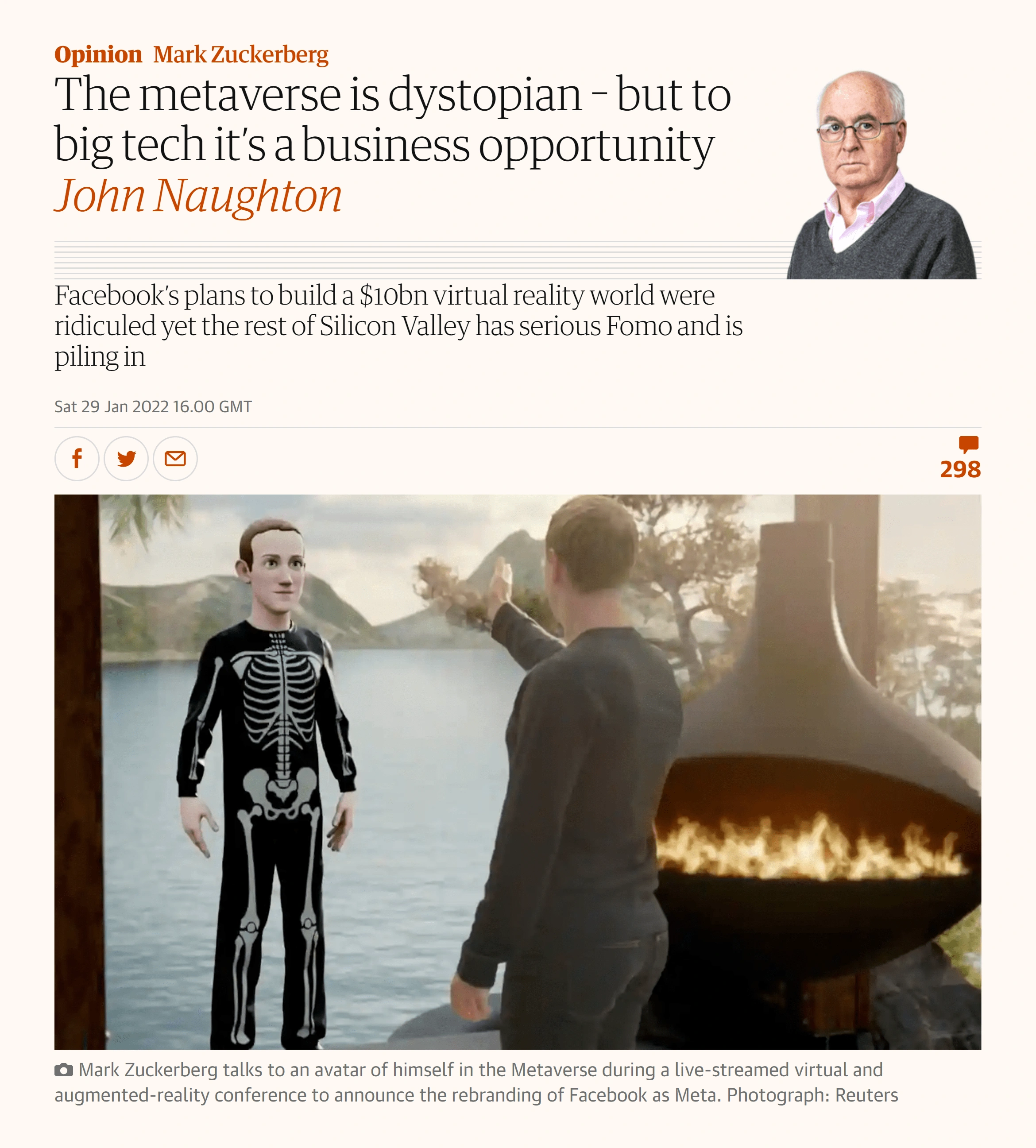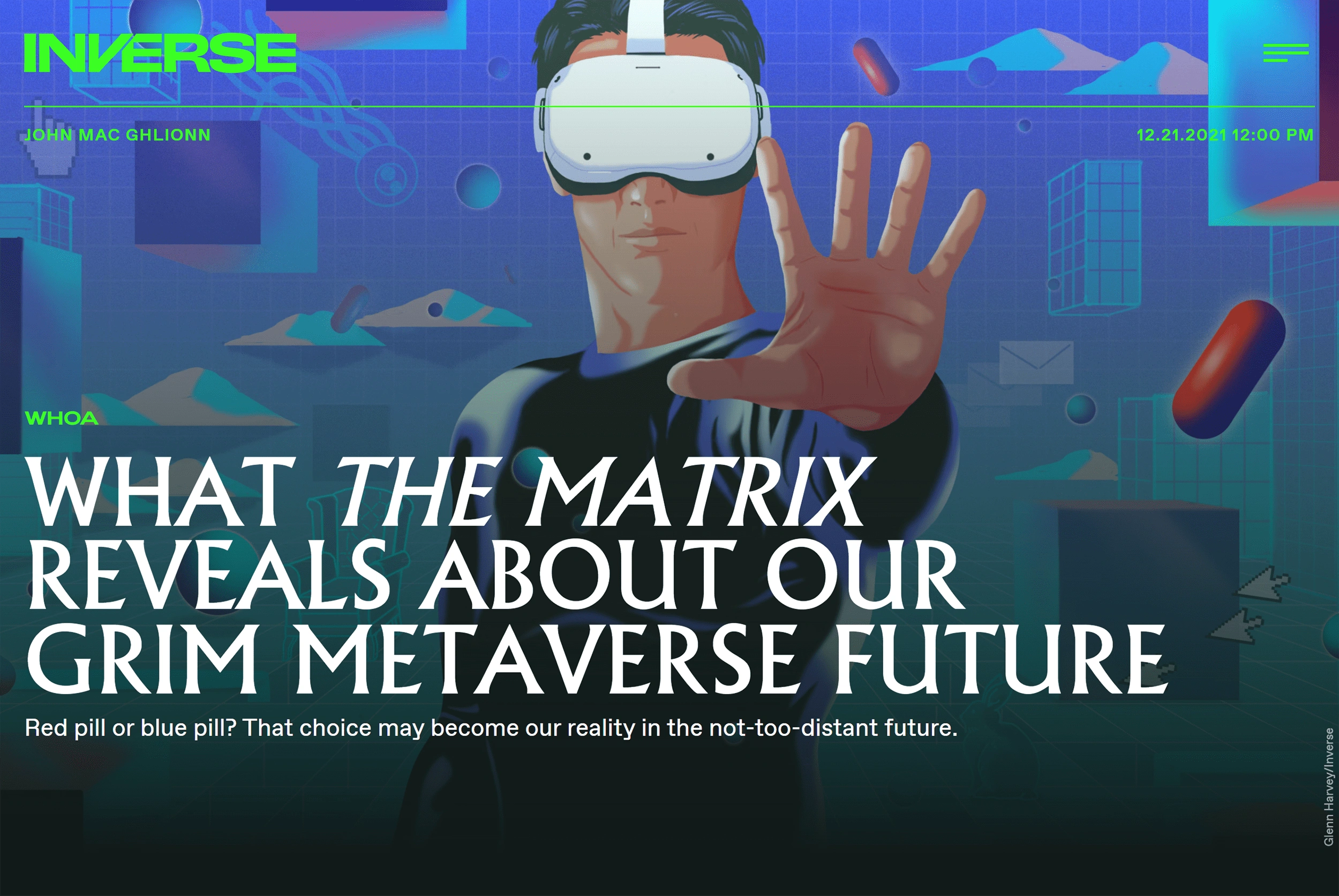
The Beginner’s Guide to the Metaverse
The Metaverse: It’s yet another buzzword that emerged in 2021.
But how much of it is hype and how much of it is the real deal?
With some of today’s largest companies investing billions into the concept, proponents argue it’s the future of how we’ll interact online.
Other more skeptical observers argue it's a passing fad, or that the metaverse is already here.
In this guide, we’ll explore the metaverse from all angles to separate the hype from reality.






Intro to Metaverse
In this chapter, we’ll define the metaverse, explore the players betting big money on its future, and discuss the origins of this emerging technology.

The metaverse is a large-scale 3D virtual environment that allows users to dynamically interact with each other. While true in a literal sense - and appropriate to the metaverse in its current state - futurists have a much more grandiose vision for what the concept could become in the future. And few have stated that vision more clearly than Tony Parisi, CEO of game development company Unity. In what’s become a highly circulated Medium article, Tony’s “Seven Rules of the Metaverse” defines this futuristic technology as follows: “The Metaverse will be an “enhanced and upgraded” version of our current-day internet that will “consistently deliver 3D content, spatially organized information and experiences and real-time synchronous communication.” In plain English, the metaverse refers to the concept of a fully immersive, fully digital world. It’s the culmination of today’s most promising, futuristic technologies: Virtual Reality, 3D visuals, digital economies (powered by NFTs, crypto and blockchain) and much, much more. As is the case with most any emerging technology (let alone a hot topic getting lots of press attention), there are strong opinions both in favor of - and against - the concept. But one thing is for sure: With many of today’s largest technology companies pouring hundreds of millions of dollars into building their own metaverse, this is a trend many people are taking seriously. Admittedly, the metaverse (as most proponents envision it) doesn’t exist yet. Because of that, the adoption of this emerging technology can’t be measured via standard metrics (monthly users, annual revenue, etc.). However, similar to how companies invested billions into building the Internet during the late 1990s and early 2000s, companies are now pouring serious money into building the infrastructure of what (they hope) will become the metaverse. As an example, Meta Platforms Inc. (aka Facebook) announced they’ll be investing $10 billion into building their own metaverse over the coming decade. Shortly after, a tech competitor announced a $67 billion acquisition of AAA gaming studio Activision. Given modern video games are the closest thing we have to a “metaverse,” many interpreted the acquisition as Microsoft’s announcement they too will be joining the fray. And it’s just not big tech companies who want to get in on the action. As of January 2022, investing heavyweights Fidelity and ProShares both announced they’ll be launching a metaverse ETF (which allows investors to invest into a basket of metaverse-focused companies). Which begs the question: What do these tech companies see that skeptics don’t? Fortunately, one doesn’t have to look far to find the answers. While the “true” metaverse will be a fully immersive digital experience (in which one wears a VR headset and fully disconnects from their local surroundings), one could argue nascent versions of the metaverse already exist. In April of 2020, more than 12 million people attended Travis Scott’s virtual Fortnite concert (Fortnite was the most popular video game in the world in 2021, and one many believe is a precursor to the future metaverse). In another video game-oriented example, more than 11 million people participate in the virtual world video game Animal Crossing (with one user claiming to have spent 2,300 hours playing the game). Admittedly, playing a video game and living in a digital world are two very different things. However, that didn’t stop Goldman Sachs from predicting the metaverse could become an $8 Trillion dollar industry. With that said, despite “metaverse” becoming one of 2021’s hottest buzzwords, in reality, the concept has been around for decades. The term “metaverse” was first coined by science fiction author Neal Stephenson in his 1992 work Snow Crash. More recently, Ernest Cline’s best-selling Ready Player One demonstrated what an actual metaverse-based society might look like. With that said, given the metaverse refers to the concept of a virtual world, some argue the metaverse is already here (and has been here for decades). As an example, players have been building virtual worlds in the popular Sims video game since it first launched in 2000. And with some pretty fancy graphics, it's hard to deny the game’s current (and fourth) version may be one of the closest examples we have as to what a metaverse might look like. In fact, the concept of building virtual worlds - known as World Building - is nothing new to gamers. Case in point: World of Warcraft. With almost five million players in 2020 alone, WoW gamers have been using avatars to build virtual worlds for years. However, there’s a massive difference between today’s video games and the metaverse envisioned by both authors and futurists alike: First, video games are played on 2D screens (from smartphones to PC monitors and even TVs). Second and most important, people interact with video games while still mentally and psychologically present in the real world. On the flip side, futurists envision the “true” metaverse as a 3D virtual reality where you are so mentally immersed you disconnect from your body’s physical surroundings. And based on some pretty funny YouTube videos, that level of immersion is not just a futuristic goal, but one that’s already here today.The Metaverse Defined
The Statistics
Searches for “Metaverse” have skyrocketed in the last two years
Searches for “Metaverse ETF” are up 4100% in the last two yearsPrecursors to the Metaverse
A Brief History of the Metaverse
Source: Blizzard
How People Will Participate in the Metaverse
In this chapter, we’ll discuss how users will participate in the metaverse on both the consumer and business side.

While some companies are exploring B2B use cases, by far the most exciting application of metaverse technology is on the consumer side. In what is arguably the most “obvious” use case, social networks like Meta (aka Facebook) expect we’ll use the metaverse to socialize. In the metaverse, unlike the “real world”, there’s no need to get dressed up, drive somewhere, and worry about getting in an accident on the drive back home. Instead, we’ll be able to sit on our couch, plop on a virtual headset, and use our virtual avatar to connect with almost anyone on the planet (in what looks like a realistic 3D world). Given we’re talking about a virtual world, the metaverse will remove geography as a limitation. In particular, users from around the world will be able to visit the digital equivalent of The Louvre, Modern Museum of Art, and even the Eiffel Tower. But it’s not just historic sites we’ll be able to interact with. Both users and developers will be able to create fantastical worlds that simply could not exist here in reality. From visiting digital renditions of distant (and imaginary) planets, to “swimming” with whales and dolphins, the only “limits” in the metaverse are the limits of human imagination. In what is a more practical use case, we’ll also be able to date in the metaverse. While you might roll your eyes and say “I would never do that…,” keep in mind millions of people said the same thing about online dating. Fast forward to today and approximately 39% of straight couples meet via online dating. Further, as users become more and more comfortable interacting in the metaverse, it’s only natural that sparks will fly. Because of that, the CEO of dating mega-app Tinder has his eyes on the metaverse as well. While it's unlikely you’ll be going on a metaverse date anytime soon, music fans have already begun dipping their toes in virtual concerts. As an example, big names like Lil Nas X and Travis Scott hosted millions of attendees as part of their virtual concerts in 2020. In fact, thanks to the pandemic lockdowns, musicians from across the globe organized a host of both concerts and full-blown virtual music festivals. Once again, these were 2D experiences most users watched on their computers or phones. However, with such large attendance numbers, it's safe to assume fans will show up for an even more impressive (and fully immersive) 3D experience. From 3D virtual dressing rooms (where consumers can use their avatars to “try on” clothes before they buy them) to the world’s first virtual Fashion Week event, fashion companies have become enamored by the possibilities the metaverse presents. On the one hand, business applications of the metaverse are nowhere near as exciting as swimming with whales on Pluto. On the other hand, the mass adoption of Zoom as a work tool is arguably a primitive version of how we’ll interact in the metaverse. Because of that, some companies are making big bets on how employees and their colleagues will meet with one another in the future. Some of today’s top tech companies - including both Meta and Microsoft - are betting on virtual meetings in a big way. To the point billionaire Bill Gates predicted virtual worlds “are the future of business meetings.” Unlike virtual dating, however, initial versions of a metaverse work environment already exist. Case in point: Workrooms. Developed by Meta Platforms (aka Facebook), Workrooms is a digital work environment replete with virtual whiteboards, digital avatars, and the ability to share your computer screen with coworkers. And in what is a direct competitor to WorkRooms, Microsoft’s Mesh platform has been available to developers and enterprise-level companies since April of 2021. Understandably, the live events industry was one of the hardest hit by the 2020 pandemic. This, in turn, acted as a tailwind to inspire entrepreneurs who envision the metaverse as the next evolution in industry conferences. And their argument is pretty strong. Similar to virtual dating and concerts, virtual conferences remove the geographic limitations (flights, travel expenses, visa restrictions) that prevent many people from attending. Because of that, companies like Orbits (not to be confused with travel giant Orbitz) and Alt Ethos are betting on metaverse events in a big way. Not everything in the metaverse needs to be grandiose, however. Instead, some companies see a virtual world as the perfect platform for rolling out product demos. With the ability to reach thousands and even millions of customers at once (for very little money), the metaverse could act as a vehicle for getting rapid feedback on prototypes and cutting-edge products. Despite the industry’s profit potential, however, not everyone is excited. Assuming the metaverse becomes as popular as social media, it will consume trillions of hours of humanity’s time (given 3.1 billion people already spend an average of 1,300 hours on social media each year). Because of that, serious questions are being asked regarding who is going to “own” the metaverse.How We’ll Spend Time as Consumers
Removing the Geographic Barrier
Virtual Dating
Searches for “Virtual dating” over the last five yearsVirtual Concerts
Virtual Events
Searches for “Virtual event” are on the rise over the last five yearsBusiness Use Cases
Virtual Meetings
Virtual Conferences
Searches for “virtual conference” spiked when the pandemic hitVirtual Product Demos
The Human Side of a (Potentially) Trillion Dollar Industry
Who Will Own the Metaverse
In this chapter, we’ll discuss the legal, moral, and philosophical issues surrounding the people and companies fighting to build and own the metaverse.

With the potential for billions of humans to immerse themselves in a virtual world, some thought leaders are beginning to ask questions regarding the moral, ethical, and even philosophical implications of having a “metaverse.” And the one question that’s on everybody’s mind: Who is going to “own” the metaverse? As an example, let’s take the world’s most popular video game: Fortnite. While millions of users play the game, at the end of the day, Epic Games (the corporation behind Fortnite) runs the show. Their developers control what happens in the game, their servers host the software that makes the game run, etc. Because of that, they make the “rules” regarding what can and cannot happen inside Fortnite. Further, Epic Games is also responsible for policing the game (which allows users to interact with one another) to prevent everything from hate speech to child predators. Along the same lines, there are serious questions regarding who will make the rules of - and police - the metaverse itself. On the one hand, it’s safe to assume the companies spending billions of dollars of their own money to build the metaverse will want to retain control of their intellectual property and creation. On the other hand, consumers’ growing mistrust of institutions (not to mention numerous tech company privacy scandals) has many people suspicious of giving tech companies so much power. Because of that, privacy advocates are waging a fierce campaign to ensure control of the metaverse remains in the hands of the public. Similar to a video or computer game, the metaverse is at its core a software program. Because of that, the real debate is whether control over the metaverse will be centralized and closed, and decentralized and open source. To illustrate the difference, you can think of the software that powers search engine Google as a centralized, closed-source platform. Centralized because Google is a private company controlled by a small number of individuals, and closed-source because the algorithms that power their services are not available to the public (and are in fact Google’s most highly guarded secret). On the flip side, the WordPress blogging platform (which powers hundreds of millions of today’s websites) is both open source and decentralized. Open source because the code is publicly available, and decentralized because there’s no individual or CEO who “owns” the rights to the WordPress software. As you can imagine from these examples, the implications of whether the metaverse should be centralized or decentralized carry massive moral and ethical implications. There are a few core arguments for a decentralized metaverse. The largest of which revolves around how Meta has dealt with scandals, privacy issues, and controversy over the past five years. According to reports, some employees are concerned about Meta’s ability to police such a massive (and psychologically powerful) platform. As an example, prior to one of Meta’s internal Q&A sessions, an employee asked the question: “How will we meaningfully put safety, integrity, and responsibility first in the Metaverse? We barely are able to cover the real world today.” Further, some would disagree Meta has actually been able to “cover the real world” as it stands today. In October of 2021, a whistleblower came out citing multiple documents that showed Facebook was aware their Instagram product both caused and exacerbated body image issues amongst teen girls, but did nothing to stop it. This, on top of the Cambridge Analytica data scandal where Facebook was caught selling private information (on upwards of 87 million Americans) to advertisers to assist in the 2016 presidential election. After watching these scandals play out on the news, a variety of academics and ethicists have begun to question whether Meta should control something that could have an even larger impact on society than social media itself. As an example, when considering Meta’s dominance over the metaverse, ethicist Don Heider said: “As an ethicist, open-source, [and open] access is always best because it facilitates more people creating, and doing so largely for the common good and social justice.” Not everyone will trust their motives. But Meta has made statements declaring they have no interest in “owning” the metaverse. Instead, they see its creation as a global collaboration between developers, civil rights groups, governments and nonprofits. With that said, not all arguments for a decentralized metaverse are based on ideology. Instead, some are based on a more practical understanding of how users will interact with the metaverse. As any serious gamer knows, today’s top games do not interact with each other. As an example, a gamer cannot take the clothes, weapons, or cars they accumulate in one game and transfer those digital assets to another game (where they would ideally be able to use said assets). The reason for this is quite simple: Today’s games aren’t designed to interact with one another. Instead, gamers rack up points, accessories, etc. inside their game of choice. Then, move on to the next one (where they repeat the process). This behavior, however, represents a huge problem for metaverse developers. Why? Because, unlike an isolated gaming world, the “metaverse” will be made up of hundreds (if not thousands) of mini-metaverses. In fact, in addition to Meta, multiple companies - including Animoca Brands, Microsoft, and Gemini - are already investing hundreds of millions of dollars into building their own versions. Think of it as the United States. In the US, there are more than 19,000 incorporated cities. Now, imagine living in a city - and having all your possessions - but not being able to take anything with you the next time you decide to travel outside the city’s limits. You can’t take your car, your clothes, or even your money. Instead, you have to start from scratch every time you set foot in a new city. Sounds like a nightmare right? Well, the same principle applies to the metaverse. With hundreds if not thousands of metaverses being built, the need to transfer digital assets between one metaverse and another is critical for mainstream adoption. Because of that, Goldman Sachs believes the metaverse absolutely must be built on a decentralized blockchain. According to a report from late 2021, Goldman analysts said: “Blockchain [is the] only technology that will allow true ownership, and seamless movement and transfer among multiple virtual worlds. If any virtual goods or services are unable to move from one space to another with the user, we believe their value is likely to be more limited.”Acknowledging the Potential for Abuse
The Centralized vs Decentralized Debate
Giving Tech Companies Too Much Power
Consumers Remain Skeptical of The Metaverse
Practical Reasons The Metaverse Should be Decentralized
Interoperability is Critical to Mainstream Adoption
The Problem With A Closed Source Metaverse
Blockchain As the Decentralized Solution
How the Metaverse Works (and Who Stands to Profit From It)
In this chapter, we’ll discuss the technology behind the metaverse, and which companies stand to profit if the trend takes off.

Unlike modern websites and games - which we interact with on our 2D device screens - the metaverse will be made up of a variety of 3D virtual worlds. Because of that, the only way to truly participate in the metaverse is through the use of 3D virtual reality goggles. On the one hand, some believe this could lead to a Matrix-like dystopian future where humans spend the majority of their time “plugged in” and out of touch with reality. On the other, both gaming and social media have become wildly popular, and many see the metaverse as the next evolution of both technologies. Regardless of one’s beliefs, entrepreneurs understand there’s serious money to be made selling the “picks and shovels” required to make an industry function. And when it comes to the metaverse, virtual reality headsets are the “ticket” required to gain entrance. Because of that, it should come as no surprise Meta is leading the pack when it comes to VR headset sales. In fact, a 2022 article showed Reality Labs (which Meta owns) generated almost $3 billion in sales of its Oculus Rift VR headset in 2021 alone. Further, Google, Microsoft, Samsung and a variety of other companies are investing resources into launching their own, competing products. Because video game worlds are the closest thing we have to a modern-day “metaverse,” many see game production studios as a major beneficiary of the metaverse trend. And nowhere is that more obvious than Microsoft’s $69 billion investment to acquire AAA gaming studio Activision. Along the same lines, investment research companies believe game development companies like Unity - which hosts 1.5 million game developers - could be a good option for investors looking to cash in on the metaverse trend. Despite this, not every company working on the metaverse is a gaming company. In addition to power players like Meta and Microsoft, a variety of companies are building their own versions of a decentralized metaverse and selling virtual land as their monetization plan. As an example, metaverse company Decentraland has upwards of 97,000 virtual plots of land listed on Opensea. Admittedly, the cheapest plot of land costs 4.6 Ether, equivalent to $12,420 as of this writing. With that said, similar to commercial real estate, owners will be able to monetize their virtual land in the future by creating attractions metaverse participants can spend virtual money at. The same goes for The Sandbox, which has over 117,000 virtual plots of land listed on Opensea (at a starting price of 3.5 Ether, equivalent to $9,450 as of this writing). In what many see as a surprising embrace, fashion companies are hopping on the metaverse trend in a big way (including the launch of the first metaverse Fashion Week in March of 2022). As an example, Nike recently purchased virtual shoe company RTFKT to help them create virtual collector’s sneakers (which, once again, will be sold as NFTs). And in a similar move, gaming giant Fortnite recently announced a partnership with luxury retailer Balenciaga to create a line of virtual clothing. Clothing that in all likelihood will be used to dress the NFTs people use as their virtual avatars in the metaverse. And it’s not just mega-brands looking to get their slice of the (future) metaverse pie. Instead, some artists are cashing in now. While buyers might not be able to use them in the metaverse quite yet, NFT avatars (known as PFPs or Profile Pics) became a hot trend in 2021. In fact, thanks to NFTs, many men and women went from starving artists to millionaire status. Admittedly, skeptics believe most NFTs will become worthless over time. However, with the metaverse years (if not decades) away, it's safe to assume digital artists will continue to cash in on the NFT avatar trend. If you know anything about gaming, you know today’s top games require special, high-performance (and highly expensive) computers to operate at peak capacity. Mainly because the graphics cards included in everyday laptops/computers aren’t capable of handling the extreme processing power required to deliver smooth 4K graphics in a highly dynamic virtual world. Along the same lines, delivering a visually impressive metaverse experience will require similar amounts of processing power. Because of that, blockchain companies like Render are taking steps to crowd-source the processing power required to render trillions of bits of digital data in HD / high fidelity. The same goes for blockchain companies like Arweave, which provide the virtual hosting infrastructure metaverse participants can use to securely store NFTs and other digital assets.The Hardware Required to Make the Metaverse Function
Virtual Reality Headset Companies
Searches for “VR headset” over the last five yearsGaming Companies Stand to Profit Big
Investing in the Metaverse’s Infrastructure
Fashion Companies Want in on the Action
Artists Selling NFTs
Searches for “NFT avatar” are skyrocketing over the last yearThe Underground Plumbing
Obstacles Facing the Metaverse Industry
In this chapter, we’ll discuss the headwinds that could hold the metaverse industry back.

A tech company’s ability to capture and hold someone’s attention is critical to achieving mainstream adoption. Executives are well aware of this already. In a 2017 interview, the CEO of Netflix famously said they’re not just competing against other streaming services, but against sleep itself. He meant that many of today’s top companies are fighting to gain as many seconds of a consumer’s attention as they possibly can (including the time we should be spending sleeping). Because of that, the days of “Build it and they will come” are long gone. Instead, success in today’s hyper-distracted world requires providing an experience that’s superior to the ten million other things consumers could spend their time on (from video games to swiping on Tinder, etc.). Unfortunately for metaverse proponents, the technology required to provide a truly impressive user experience is years (if not decades) away. If you’re over age 30, however, you know technologists said the same thing about virtual reality, robots, and flying cars. Predictions that - decades later - have yet to materialize. Because of that, one of the largest obstacles facing the metaverse is the fact that, in 2022, the technology just isn’t ready yet. With that said, the graphics on today’s top video games have become incredibly realistic. And with companies like Microsoft partnering with top-tier game studios to bring the metaverse into reality, odds are we’ll start to see basic (yet functional) metaverse worlds in the near future. While Zoom was a lifesaver to many businesses during the pandemic, the overreliance on digital meetings quickly devolved into a nationwide phenomenon known as Zoom Fatigue. On the one hand, there’s a gargantuan difference between staring at your coworker’s faces and playing a top-of-the-line video game. In fact, while most people can’t wait to get off Zoom, the average gamer spends upwards of eight hours per week playing. On the other hand, there’s a big difference between playing a video game (which has been configured to maximize dopamine dumps) and socializing with strangers in a virtual world. So while the metaverse may be a cool tool for holding holographic Facetime meetings with family and friends, Zoom Fatigue provides evidence there may be limits to how much time people are willing to spend “socializing” online. While they’re unlikely to prevent the metaverse from being built, a growing number of consumers (and big-name CEOs) see virtual worlds as a serious step towards a dystopian future. In some cases, critics are quick to call out how spending time in a virtual world isn’t that much different from how the characters in the Matrix movie “plugged into” the Matrix itself. Admittedly, using a pair of VR goggles and plugging a computer cable into your skull are two very different things. However, with Elon Musk investing serious resources into creating the world’s first computer chip brain implant (known as Neuralink), the possibility of plugging into the metaverse via direct brain connection does exist (albeit far in the future). Making a slightly more practical argument are children’s health experts who’ve observed social media’s negative effect on both kids’ and teenagers’ mental health. To demonstrate just how dangerous some believe social media has become, a recent Netflix documentary highlighted how multiple executives (including ones responsible for building platforms like Twitter, Instagram and Facebook) refuse to let their children use social media. Considering the metaverse will be dramatically more immersive than a smartphone app, an increasing number of experts are raising the alarm regarding the negative impact metaverse usage could have on children’s and teens’ mental health. Admittedly, it's unlikely mental health experts will have much say in the development of the metaverse. The government, however, will. In what may be the largest threat of all, government regulators may be hesitant to give tech companies control over what is essentially a virtual society. In fact, even without the metaverse, governments across the globe have charged companies like Facebook, Google and Microsoft with various antitrust cases related to what regulators see as monopolistic business practices. Further, while tech giants like Amazon and Apple are in the business of selling physical goods, one could argue Meta and Microsoft are the only companies with the resources needed to build the type of metaverse that eventually goes mainstream. Regardless of their abilities, however, government regulators may attempt to squash tech company’s plans before they even get off the ground.User Experience Over Everything
The Technology Just Isn’t Up to Par
Grand Turismo 7Zoom Burnout & Consumer Hesitancy
Searches for “Zoom” had their peak at the start of the pandemic but they are steadily dropping offThe Dystopian Narrative
The Effect of Social Media On Children’s Mental Health
Antitrust Laws
Conclusion
Are there legitimate concerns about the metaverse? Yes, of course. Is today's technology capable of meeting the industry’s needs? No, not yet. With that said, the same could be said about Web 1.0, Web 2.0, and the emerging cryptocurrency space. All of which have grown into the mainstream, trillion-dollar industries. So, while the metaverse may be in its infancy - and facing some serious headwinds - there’s no denying this will be an exciting trend to watch over the coming years.



